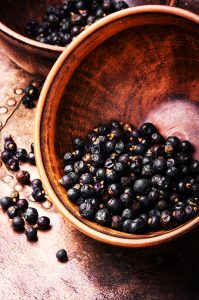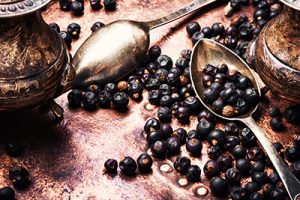Juniper berry description:
Juniperus communis Juniper, Juniper communis, Juniper communis, Juniper, Juniper communis, Juniper communis Cupressaceae – cypress family The Scots pine is a shrub up to 3 m tall, exceptionally it can also take the form of a tree and grow up to 10 m tall. It often has a very beautiful cone shape, and sometimes the stems are drooping. The leaves are narrow, needle-shaped, pointed and very prickly. There are usually 3 leaves per stem at the same height. The leaves of juniper are green even in winter; they live for 4-5 years until they fall off with the scales of the stem bark. The flowers are in the axils of the leaves. The juniper is a dioecious shrub, i.e. one bush has only stamens and the other only pure fruiting flowers. The staminate flowers form tiny racemes and consist of small, densely packed scales, each of which bears mostly 3 anthers on the underside. These anthers  develop abundant yellow pollen when torn open. The productive flower is very short, almost spherical, and when the seeds are formed it becomes a berry. The juniper berry is twisted at the tip, indicating that it has been formed by the fusion of 3 scales. The juniper berry is green in the first year and only ripens in the second year, when it becomes blackish dark brown and coated with a blue ash that can be wiped off. The ripe berry is spherical, up to 9 mm. in diameter and contains 3 hard-walled seeds. The flesh is brown in colour and has a succulent flavour due to the volatile oil it contains. The juniper flowers in April-May and the berries ripen the following year.
develop abundant yellow pollen when torn open. The productive flower is very short, almost spherical, and when the seeds are formed it becomes a berry. The juniper berry is twisted at the tip, indicating that it has been formed by the fusion of 3 scales. The juniper berry is green in the first year and only ripens in the second year, when it becomes blackish dark brown and coated with a blue ash that can be wiped off. The ripe berry is spherical, up to 9 mm. in diameter and contains 3 hard-walled seeds. The flesh is brown in colour and has a succulent flavour due to the volatile oil it contains. The juniper flowers in April-May and the berries ripen the following year.
 Occurrence of juniper berries:
Occurrence of juniper berries:
Juniper grows in the pine forests of our mountainous regions. It is found mostly on the edges of forests and in clearings. It is found on sunny hills and forest edges throughout Europe and Russian Asia. At higher altitudes it will be smaller and decumbent, but in the interior of Norway and Sweden it can live for centuries, growing to 10-12 cm tall. In our country it grows in forests, hilly areas and sporadically throughout the country.
Drugs:
– Juniperi pseudo fructus: berry, listed in Hungarian Herb Book VIII, min. 1 % essential oil – (pseudo-fruit) – Juniperi aetheroleum: essential oil, listed in Hungarian Herbal Book VIII, – essential oil – Pix juniperi – juniper tar
Active principles of juniper berry:
– 1,5-2 % essential oil – Resin, tanning agent, 20-25 % invert sugar (ferment)
Juniper berry, medicinal properties, uses:
– Diuretic, diaphoretic – mild antispasmodic – digestive, bile stimulant, appetite stimulant – respiratory stimulant – antibacterial – blood sugar lowering
Conventional use:
– Diuretic, diaphoretic, appetite stimulant – aids digestion and sweating. – Juniper oil: o externally as a rub for rheumatic complaints o internally, a diaphoretic, antispasmodic, soothing to the bronchi (bronchial tubes).
Preclinical studies:
– Invitro: antiseptic, antimicrobial; essential oil is a moderate antioxidant (against Candida). – In rats, its extract has been shown to have antihypertensive and analgesic effects. No human evidence.
Indications:
– Internally: for loss of appetite; for urinary tract inflammation, as a diuretic. – Externally: anti-rheumatic, for muscle pain. – Dosage internally: daily max: 10 g berries, prepared with 150 ml of boiling water.
Contraindications:
- Slightly irritating. Stimulates the smooth muscles of the uterus, so pregnant women should avoid. Not recommended in chronic kidney inflammation, impaired kidney function, pregnancy and lactation.
Juniper berries are sold under the name juniperi pseudo fructus and are used in pharmacies to make pine berry juice(roob juniperi) and juniper oil (juniperi aetheroleum). The essential oil is obtained by steam distillation. The berries themselves are also used in medicine, and even the juniper tree, which is also used to make oil. The berries have a bitter-sweet taste and, when thrown over glowing embers, give off a very fragrant, balsamic scent. Juniper berries are a stomach tonic and diuretic, giving the urine a faint violet smell. Juniper berries gently stimulate the digestive organs, promote mucous membrane function, as well as skin exudation and urine excretion. Juniper berries are used to make a brandy called juniper or pine water, and are also used as a spice. Its berries, shoots and leaves are also used for incense.
 Uses:
Uses:
– Spice – Tea mixtures – Essential oil: for rubbing – As drops: appetizer. – Decoction of crushed berries: inhibits the formation of kidney stones. – Spiritus juniperi (alcoholic extract): for indigestion.
Taking juniper berries:
Juniper berries( also calledbaccae juniperi ) should be picked when they are ripe, in the autumn of the second year. The juniper berry is pea-sized, round, fleshy, with a triple scar on the top, black-violet in colour when raw, shiny when it is picked. Picking juniper berries is a profitable source of income, especially for poor people living in the northern part of the country. The picked berries can either be sold without any treatment or they can be dried slowly and evenly. The well-dried juniper berries are black and shiny. Green, brown or red berries are worthless and must be picked. The green juniper berries contain most of the volatile oil and therefore have a stronger smell and a more succulent flavour, but lack the sweet taste. The berries can be transported in baskets. Source: Béla Páter, Wild Herbs Dr. Ferenc Darvas and Dr. Gyula Magyary-Kossa,Domestic medicinal plants, their production, marketing, effects and medicinal uses

